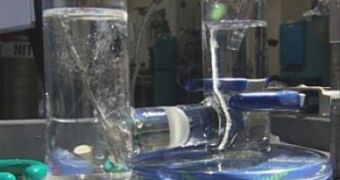A new type of material developed at the Massachusetts Institute of Technology is now revealed by chemist Daniel Nocera as a possible means to conduct water electrolysis processes at room temperatures with the input of relatively low electric currents. The material could be used to chemically store solar energy and efficiently use it later.
Water electrolysis, the process through which water is split into its basic constituents - hydrogen and oxygen - uses expensive materials, such as platinum, as electrodes. Also, the electrolytic solution must have a high pH, not to mention that the procedure requires the input of a fair amount of electric current. The new material however, is inexpensive, can act as electrode in water electrolysis, requires neutral pH solution and can generate hydrogen and oxygen by making use of small amounts of electricity.
Nocera says that this way, electric power generated by solar panels during the day could be used efficiently to generate hydrogen and oxygen, which can be then used at night to produce electric currents inside fuel cells. The material consists of a combination of cobalt and phosphate that is deposited on an indium-tin-oxide electrode. This unique mix appears to catalyze the water electrolysis process, although the exact mechanism responsible for this effect is largely unknown.
"We have to have catalysts which are cheap, and we have to have systems which are very robust. I see this as one big step in that direction," said biochemist James Barber of the Imperial College London about the work done by Nocera. Barber added that with the new electrode the water electrolysis process can produce the same amount of oxygen by using only 1 volt, rather than 1.6 volts in the case of more traditional methods.
However, there is a catch. According to Richard Eisenberg of the University of Rochester, New York, the electrolysis process envisioned by Nocera can only produce oxygen, the hydrogen gas being retained by the electrolytic solution. Therefore, other processes are required in order to generate the hydrogen, so that electric current can be produced inside fuel cells.
"Someone will also need to determine exactly how Nocera's catalyst is driving the water oxidation reaction. Just obtaining the oxygen is an excellent development on a very difficult and keenly important problem," Eisenberg said.

 14 DAY TRIAL //
14 DAY TRIAL //